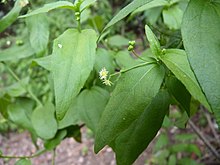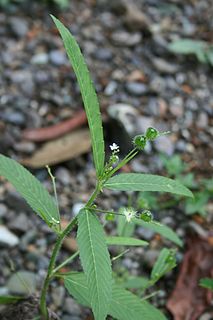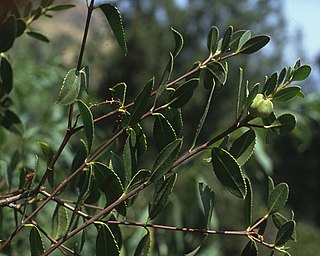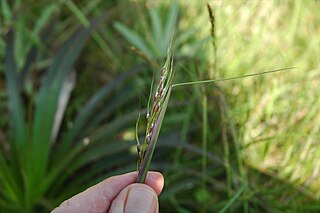| Chiropetalum | |
|---|---|
 | |
| Chiropetalum tricuspidatum | |
| Scientific classification | |
| Kingdom: | Plantae |
| (unranked): | Angiosperms |
| (unranked): | Eudicots |
| (unranked): | Rosids |
| Order: | Malpighiales |
| Family: | Euphorbiaceae |
| Subfamily: | Acalyphoideae |
| Tribe: | Chrozophoreae |
| Subtribe: | Ditaxinae |
| Genus: | Chiropetalum A.Juss. |
| Synonyms [1] [2] | |
| |
Chiropetalum is a plant genus of the family Euphorbiaceae first described as a genus in 1832. [3] [2] It is widespread across relatively dry regions of North and South America from Texas to Uruguay. [1] [4] [5] [6]

Plants are mainly multicellular, predominantly photosynthetic eukaryotes of the kingdom Plantae. Historically, plants were treated as one of two kingdoms including all living things that were not animals, and all algae and fungi were treated as plants. However, all current definitions of Plantae exclude the fungi and some algae, as well as the prokaryotes. By one definition, plants form the clade Viridiplantae, a group that includes the flowering plants, conifers and other gymnosperms, ferns and their allies, hornworts, liverworts, mosses and the green algae, but excludes the red and brown algae.
A genus is a taxonomic rank used in the biological classification of living and fossil organisms, as well as viruses, in biology. In the hierarchy of biological classification, genus comes above species and below family. In binomial nomenclature, the genus name forms the first part of the binomial species name for each species within the genus.
Family is one of the eight major hierarchical taxonomic ranks in Linnaean taxonomy; it is classified between order and genus. A family may be divided into subfamilies, which are intermediate ranks between the ranks of family and genus. The official family names are Latin in origin; however, popular names are often used: for example, walnut trees and hickory trees belong to the family Juglandaceae, but that family is commonly referred to as being the "walnut family".
- Species [1]
- Chiropetalum anisotrichum - Rio Grande do Sul
- Chiropetalum argentinense - N Argentina
- Chiropetalum astroplethos - Coahuila, Nuevo León, Texas, Veracruz
- Chiropetalum berterianum - Chile
- Chiropetalum boliviense - Bolivia, NW Argentina
- Chiropetalum canescens - N Chile
- Chiropetalum cremnophilum - N Chile
- Chiropetalum foliosum - S Brazil
- Chiropetalum griseum - Brazil, N Argentina, Paraguay
- Chiropetalum gymnadenium - Minas Gerais, São Paulo
- Chiropetalum intermedium - Uruguay, Buenos Aires
- Chiropetalum molle - Rio Grande do Sul
- Chiropetalum patagonicum - Argentina
- Chiropetalum pavonianum - Peru
- Chiropetalum phalacradenium - Santa Catarina
- Chiropetalum pilosistylum - Rio Grande do Sul
- Chiropetalum puntaloberense - Uruguay
- Chiropetalum quinquecuspidatum - Peru
- Chiropetalum ramboi - Rio Grande do Sul
- Chiropetalum ruizianum - Peru
- Chiropetalum schiedeanum - Mexico
- Chiropetalum tricoccum - S Brazil, N Argentina, Paraguay, Uruguay
- Chiropetalum tricuspidatum - Chile
















